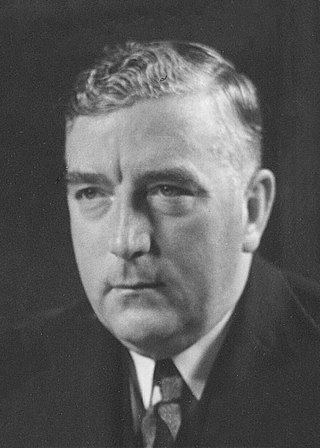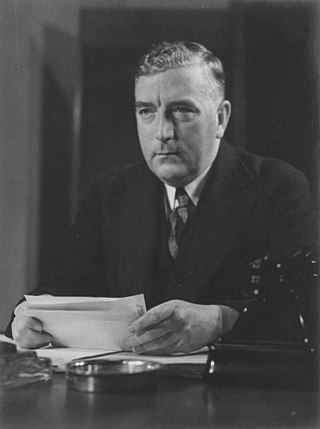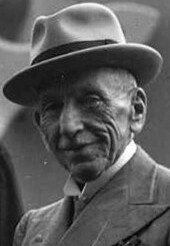| ||||||||||||||||||||||
| ||||||||||||||||||||||
| ||||||||||||||||||||||
A by-election was held in the Henty electorate in the eastern suburbs of Melbourne on 30 March 1946, following the resignation of independent MP Arthur Coles.
| ||||||||||||||||||||||
| ||||||||||||||||||||||
| ||||||||||||||||||||||
A by-election was held in the Henty electorate in the eastern suburbs of Melbourne on 30 March 1946, following the resignation of independent MP Arthur Coles.
Coles, a prominent businessman and founder of the Coles supermarket chain, had won the seat as an independent United Australia Party candidate at the 1940 federal election. The seat had been left open due to the death of incumbent MP Henry Gullett, a senior minister in the Menzies government, in the Canberra air disaster five weeks before the election.
Coles had duly joined the United Australia Party in early 1941, but resigned in August that year after Menzies was deposed as leader. He subsequently joined with another independent, Alexander Wilson, to vote down the Fadden UAP government in October 1941, installing Labor leader John Curtin as Prime Minister. He had generally been seen as sympathetic to Labor thereafter, and was re-elected in 1943 against Gullett's son, Henry "Jo" Gullett. In February, 1946, he was appointed chairman of the new Australian National Airlines Commission by Curtin's successor Ben Chifley, thus necessitating his resignation from parliament, which occurred on 12 February.
| | This section is empty. You can help by adding to it. (July 2010) |
| Party | Candidate | Votes | % | ±% | |
|---|---|---|---|---|---|
| Liberal | Jo Gullett | 38,718 | 54.32 | +16.24 | |
| Labor | Val Doube | 32,556 | 45.68 | +45.68 | |
| Total formal votes | 71,274 | 98.50 | +1.89 | ||
| Informal votes | 1,086 | 1.50 | −1.89 | ||
| Turnout | 72,360 | 89.46 | −8.07 | ||
| Liberal gain from Independent | Swing | +16.24 | |||

The United Australia Party (UAP) was an Australian political party that was founded in 1931 and dissolved in 1945. The party won four federal elections in that time, usually governing in coalition with the Country Party. It provided two prime ministers: Joseph Lyons (1932–1939) and Robert Menzies (1939–1941).

John Curtin was an Australian politician who served as the 14th prime minister of Australia from 1941 until his death in 1945. He held office as the leader of the Australian Labor Party (ALP), having been most notable for leading the country through the majority of World War II, including all but the last few weeks of the war in the Pacific. Curtin's leadership skills and personal character were acclaimed by his political contemporaries, and he is frequently ranked as one of Australia's greatest prime ministers and political leaders.

Francis Michael Forde was an Australian politician who served as the 15th prime minister of Australia from 6 to 13 July 1945, in a caretaker capacity following the death of John Curtin. He was deputy leader of the Australian Labor Party (ALP) from 1932 to 1946 and is the shortest-serving prime minister in Australia's history.

Sir Arthur William Fadden was an Australian politician and accountant who served as the 13th prime minister of Australia from 29 August to 7 October 1941. He held office as the leader of the Country Party from 1940 to 1958 and served as treasurer of Australia from 1940 to 1941 and 1949 to 1958.

Sir Arthur William "A.W." Coles was a prominent Australian businessman and philanthropist, a son of St James, Victoria shopkeeper George W. Coles.

Archie Galbraith Cameron was an Australian politician. He was a government minister under Joseph Lyons and Robert Menzies, leader of the Country Party from 1939 to 1940, and finally Speaker of the House of Representatives from 1950 until his death.

The Liberal–National Coalition, commonly known simply as the Coalition or the LNP, is an alliance of centre-right to right-wing political parties that forms one of the two major groupings in Australian federal politics. The two partners in the Coalition are the Liberal Party of Australia and the National Party of Australia. Its main opponent is the Australian Labor Party (ALP); the two forces are often regarded as operating in a two-party system. The Coalition was last in government from 2013 to 2022. The group is led by Peter Dutton, who succeeded Scott Morrison after the 2022 federal election.

The Fadden ministry was the 28th ministry of the Government of Australia. It was led by the country's 13th Prime Minister, Arthur Fadden. The Fadden ministry succeeded the Third Menzies ministry, which dissolved on 28 August 1941 following the resignation of Robert Menzies as Prime Minister. A subsequent joint meeting of the Coalition parties elected Country leader Fadden as Menzies' successor. The ministry was replaced by the First Curtin ministry on 7 October 1941 after the independent crossbenchers Alexander Wilson and Arthur Coles withdrew their support for the Fadden government and voted with John Curtin and his Labor Party to bring the government down in a de facto no-confidence motion.

Edward John Ward was an Australian politician who represented the Australian Labor Party (ALP) in federal parliament for over 30 years. He was the member for East Sydney for all but six and a half weeks from 1931 until his death in 1963. He served as a minister in the Curtin and Chifley governments from 1941 to 1949, and was also known for his role in the ALP split of 1931.

Sir Henry Somer Gullett KCMG CB was an Australian journalist, military historian and politician. He was a war correspondent during World War I and co-authored the official history of Australia's involvement in the war. He later served in federal parliament from 1925 to 1940 and held senior ministerial office.

The 1943 Australian federal election was held in Australia on 21 August 1943. All 74 seats in the House of Representatives and 19 of the 36 seats in the Senate were up for election. The incumbent Labor Party, led by Prime Minister John Curtin, defeated the opposition Country–UAP coalition led by Arthur Fadden in a landslide. The Labor party TPP result of 58.2% is its highest, in its history.

The 1940 Australian federal election was held in Australia on 21 September 1940. All 74 seats in the House of Representatives and 19 of the 36 seats in the Senate were up for election. The incumbent Coalition, consisting of the United Australia Party led by Prime Minister Robert Menzies and the Country Party led by Archie Cameron, defeated the opposition Labor Party under John Curtin despite losing the overall popular vote.

Although most Australian civilians lived far from the front line, the Australian home front during World War II played a significant role in the Allied victory and led to permanent changes to Australian society.
This is a list of the members of the Australian House of Representatives in the 17th Australian Parliament, which was elected at the 1943 election on 21 August 1943. The incumbent Australian Labor Party led by Prime Minister of Australia John Curtin defeated the opposition Country Party led by Arthur Fadden with coalition partner the United Australia Party (UAP) led by Billy Hughes. On 21 February 1945, the parliamentary UAP was dissolved and replaced by the newly established Liberal Party.
This article provides information on candidates who stood for the 1946 Australian federal election. The election was held on 28 September 1946.

The 1941 New South Wales state election was held on 10 May 1941. This election was for all of the 90 seats in the 33rd New South Wales Legislative Assembly and was conducted in single-member constituencies with compulsory preferential voting.

The Curtin government was the federal executive government of Australia led by Prime Minister John Curtin. It was made up of members of the Australian Labor Party in the Australian Parliament from 1941 to 1945.

The Menzies government (1939–1941) refers to the federal executive government of Australia led by Prime Minister Robert Menzies. Menzies led the United Australia Party in the Australian Parliament from 1939 to 1941. Menzies served a later and longer term as prime minister as leader of a successor party, the Liberal Party of Australia from 1949 to 1966.

The Fadden government was the federal executive government of Australia led by Prime Minister Arthur Fadden, as leader of the Country Party. He was appointed prime minister on 29 August 1941, during World War II, following the resignation of Robert Menzies of the United Australia Party (UAP). Fadden continued the coalition government between the Country Party and the UAP, but after just over one month in office the government was defeated on a confidence motion. Fadden was succeeded as prime minister on 7 October 1941 by John Curtin of the Australian Labor Party (ALP).

The United Australia Party (UAP) held a leadership election on 9 October 1941, following the resignation of Robert Menzies on the same day. Billy Hughes was elected as his replacement.